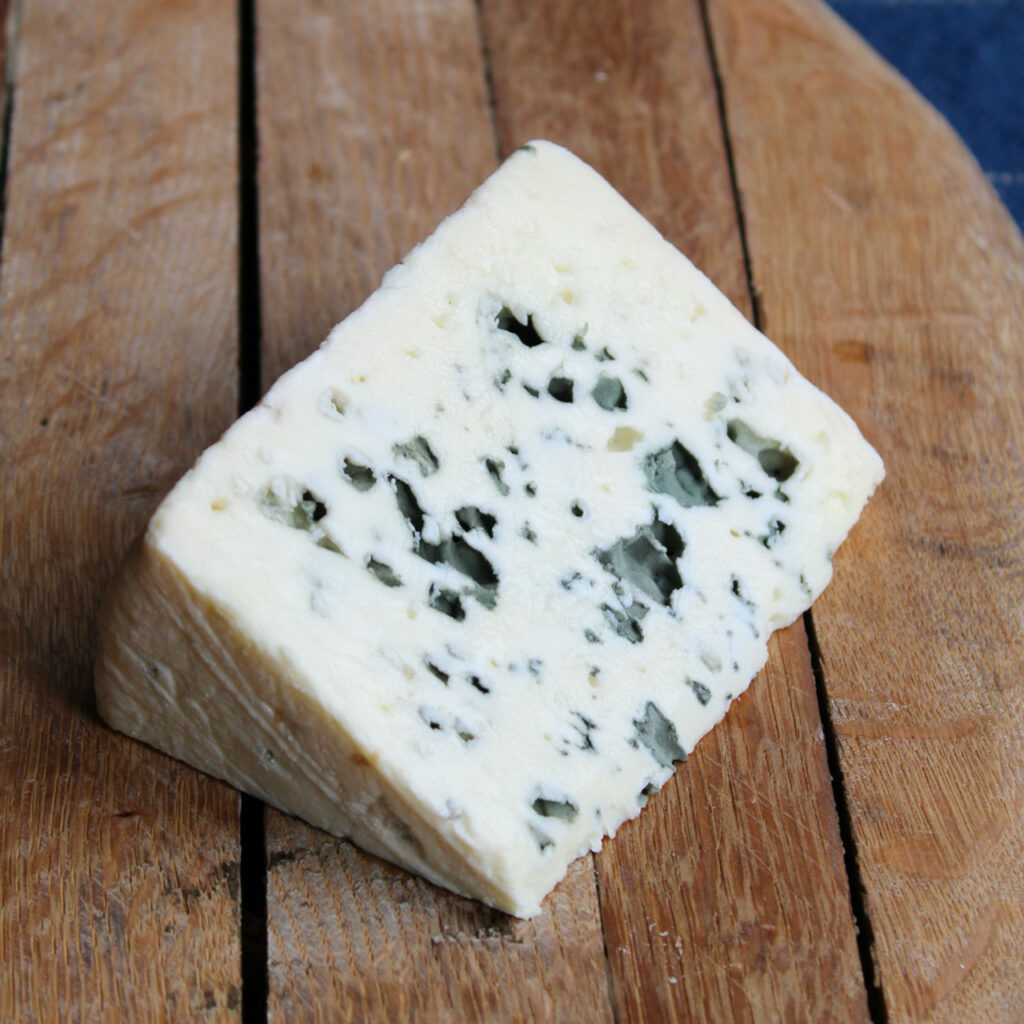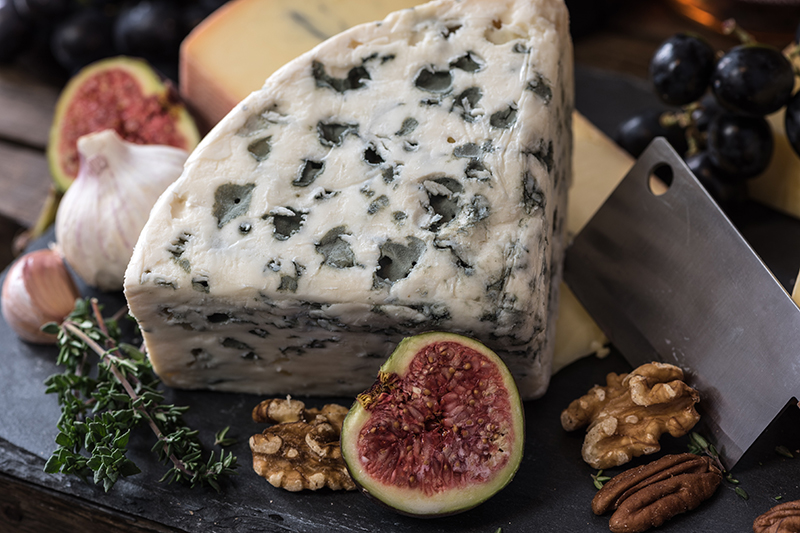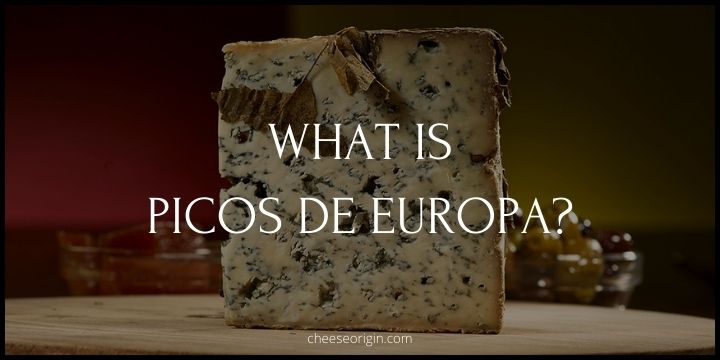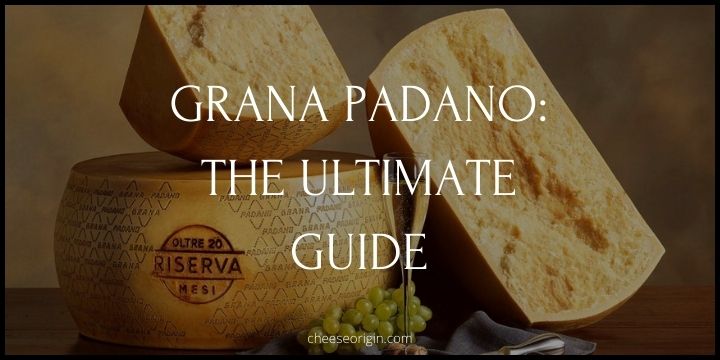What is Roquefort? An Insider’s Guide to the King of Blue Cheese

Welcome to the world of Roquefort, often hailed as the ‘King of Blue Cheese’. This post is your passport to an exciting journey through the rich, tangy, and complex realm of this iconic cheese.
As we delve into the fascinating history, unique production process, and unmatched flavor profile of Roquefort, you’ll gain a new appreciation for why this cheese has been adored by gourmands for centuries.
So grab a glass of your favorite wine, sit back, and prepare to embark on an insider’s tour of the regal world of Roquefort cheese. Whether you’re a seasoned cheese-lover or a curious foodie, this guide will offer a fresh perspective and deepen your understanding of this blue-veined delicacy.
Quick facts about Roquefort
| Quick Facts | Description |
|---|---|
| Origin | Roquefort-sur-Soulzon, France |
| Made from | Ewe’s milk |
| Texture | Semi-soft, crumbly |
| Flavor | Tangy, sharp, salty |
| Type | Blue cheese |
| Aging time | Minimum of 3 months |
| Protected Designation of Origin (PDO) | Yes, since 1925 |
| Uses | Great for salads, on bread, or with wine |
What is Roquefort?

Roquefort is a world-renowned blue cheese from the village of Roquefort-sur-Soulzon in southern France. It’s known for its tangy, sharp, and slightly salty flavor, balanced by a creamy, crumbly texture.
This cheese is made exclusively from the milk of the Lacaune breed of sheep and aged in the natural caves of the region, which gives it its unique taste and character.
Roquefort is one of the oldest known cheeses, with records dating back to AD 79. It was also the first cheese to be granted a Protected Designation of Origin (PDO) in 1925, meaning that only cheese aged in the natural caves of Roquefort-sur-Soulzon can bear the name ‘Roquefort’.
Whether enjoyed on its own, crumbled over a salad, spread on bread, or paired with a robust red wine, Roquefort offers a unique and satisfying culinary experience.
Are blue cheese and Roquefort the same?
While Roquefort is a type of blue cheese, not all blue cheeses are Roquefort.
Blue cheese is a general term used to describe a variety of cheeses that have had cultures of the mold Penicillium added to them, resulting in spots or veins of blue, blue-gray or blue-green mold throughout the cheese.
Roquefort, on the other hand, is a specific kind of blue cheese that is made from sheep’s milk and aged in the natural caves of Roquefort-sur-Soulzon in France. It has a distinct flavor, which is sharp, tangy and slightly salty, and a crumbly texture.
Furthermore, Roquefort has a Protected Designation of Origin (PDO) status, which means that only cheese aged in the natural caves of Roquefort-sur-Soulzon can bear the name ‘Roquefort’.
So while all Roquefort is blue cheese, not all blue cheese can be called Roquefort.
>> Click here to read our in-depth guide on Blue Cheese
What does Roquefort taste like?

The flavor of Roquefort is complex. It’s primarily savory and salty, with a notable tang imparted by the blue veins of mold running throughout the cheese. These veins also give the cheese a bit of a spicy kick.
Despite its intensity, Roquefort also has subtle notes of sweet, nutty caramel and a slight earthiness.
It’s important to note that the flavor can vary depending on the age of the cheese. Younger Roquefort tends to be milder and creamier, while older Roquefort is more pungent and spicy.
Because of its strong flavor, Roquefort is often used sparingly and is excellent when paired with sweet accompaniments like honey or figs, or bold red wines.
Roquefort tasting notes
- Appearance: Roquefort is a white to off-white cheese with distinctive blue-green veins running throughout. It has a natural, edible rind that is slightly moist and crumbly.
- Texture: The cheese has a moist, crumbly texture that becomes creamier as it melts in the mouth. Despite its crumbliness, it’s not dry, but rather quite rich and buttery.
- Aroma: Roquefort has a strong, pungent aroma that is earthy and a bit musty due to the blue mold. There may also be a hint of sweetness to the scent.
- Taste: The flavor of Roquefort is complex and robust. It’s primarily savory and salty, with a distinct tanginess from the blue mold. There’s a bit of a spicy kick that comes from the blue veins. Beneath these stronger flavors, there are subtle notes of sweet caramel and a nutty richness. The finish is long and lingering, with a pleasant aftertaste.
- Pairings: Due to its strong flavor, Roquefort pairs well with sweet accompaniments like honey, figs, or pears. It’s also excellent with crusty bread, walnuts, and bold red wines or sweet dessert wines.
What is special about Roquefort cheese?
Roquefort is a type of blue cheese that is considered one of the world’s best-known blue-veined cheeses. It hails from the village of Roquefort-sur-Soulzon in southern France.
- Sheep’s Milk: Roquefort is made exclusively from the milk of the Lacaune breed of sheep that graze on the diverse flora of the region.
- Blue Veins: The cheese is known for its characteristic blue-green veins, which are a result of the Penicillium roqueforti mold.
- Aging Process: The cheese is aged for a minimum of three months in the natural limestone caves of the area. This unique aging process gives Roquefort its distinct flavor and aroma.
- Protected Designation of Origin (PDO): Roquefort was the first cheese to receive a PDO status in 1925. This means that only cheese aged in the natural caves of Roquefort-sur-Soulzon can bear the name ‘Roquefort’.
- Taste Profile: Roquefort has a complex flavor profile. It’s tangy, sharp, and slightly salty with a creamy and crumbly texture.
Roquefort is commonly used in salads and dressings, but it’s also excellent on its own or paired with wine.
What is the difference between Roquefort and Gorgonzola blue cheese?
Roquefort and Gorgonzola are both types of blue cheese, but they have several key differences due to their geographical origins, production methods, and flavor profiles.
| Roquefort | Gorgonzola |
|---|---|
| Originates from Roquefort-sur-Soulzon, France. | Originates from Lombardy, Italy. |
| Made from the milk of the Lacaune breed of sheep. | Primarily made from unskimmed cow’s milk. |
| Aged for a minimum of three months in natural limestone caves. | Aged for three to four months (Gorgonzola Dolce) or up to a year (Gorgonzola Piccante). |
| Has a PDO status, meaning it can only be called ‘Roquefort’ if it is aged in the natural caves of Roquefort-sur-Soulzon. | Also has a PDO status, meaning it can only be called ‘Gorgonzola’ if it is produced in certain regions of Italy. |
| Flavor profile is tangy, sharp, and slightly salty with a creamy and crumbly texture. | Gorgonzola Dolce is sweet and creamy while Gorgonzola Piccante is sharp and crumbly. |
| Blue-green veins are a result of Penicillium roqueforti mold. | Blue or blue-green veins are a result of Penicillium glaucum mold. |
While both are blue cheeses, their taste, texture, and production methods differ significantly due to the different milks used, aging processes, and specific molds that give them their distinctive veins and flavors.
>> Click here to read our in-depth guide on Gorgonzola
Is Roquefort a good cheese?
Roquefort is often highly regarded in the world of cheese for its unique characteristics. Here are a few reasons why Roquefort might be considered a “good” cheese:
- Distinct Flavor: Roquefort has a unique, complex flavor that is tangy, sharp, and slightly salty. It’s this strong and distinctive taste that makes it a favorite among many cheese lovers.
- Rich History: Roquefort is one of the world’s oldest known cheeses. It’s been made in the same region of France, using the same methods, for thousands of years.
- Versatility: While Roquefort is often enjoyed on its own or with bread, it can also be used in a variety of dishes, including salads, pastas, and sauces, adding a depth of flavor.
- Health Benefits: Roquefort contains a good amount of protein and calcium, as well as several vitamins and minerals.
However, it’s worth noting that Roquefort is a blue cheese, and its strong flavor may not appeal to everyone.
Like any cheese, whether you consider it “good” or not will ultimately depend on your personal taste.
How do the French eat Roquefort cheese?
- As is or on Bread: Many French people enjoy Roquefort ‘as is’, typically in small pieces, or on a slice of baguette with a bit of butter. It’s a common practice to not cut off “the nose” (the tip) of the wedge-shaped cheeses like Roquefort.
- In Salads and Dressings: Roquefort is often used in different salads and dressings due to its rich and tangy flavor that complements many types of greens and vegetables.
- Paired with Fruits and Nuts: The cheese pairs very well with fruits such as figs and a variety of nuts, creating a balance between sweet and savory flavors.
- In Various Dishes: The richness of Roquefort cheese complements a wide range of foods, and it can be used in several dishes, including pastas and sauces, adding a depth of flavor.
Also read: What Fruit Goes on a Charcuterie Board?
Is Roquefort healthy?
Benefits:
- Rich in Nutrients: Roquefort is high in protein and a good source of calcium, both of which are essential for health. It also contains several vitamins and minerals, including vitamin A, vitamin B2 (riboflavin), and zinc.
- Contains ‘Good’ Fats: While Roquefort does contain fat, a portion of this is unsaturated fats, which are considered heart-healthy.
- Source of Probiotics: Roquefort is a fermented food, which means it contains probiotics. These beneficial bacteria can support gut health.
Drawbacks:
- High in Sodium: Like many cheeses, Roquefort is high in sodium, which can contribute to high blood pressure if consumed in excess.
- High in Fat: While some of the fat in Roquefort is the heart-healthy kind, it is still high in saturated fats. Too much saturated fat can increase your levels of “bad” LDL cholesterol and increase your risk of heart disease.
It’s important to consume Roquefort as part of a balanced diet and not in excess. If you have specific dietary concerns or health conditions, it’s best to consult with a healthcare professional or a dietitian.
Roquefort nutrition facts
| Nutrient | Amount per 28g Serving |
|---|---|
| Calories | 105 |
| Total Fat | 8.7g |
| – Saturated Fat | 5.5g |
| Cholesterol | 26mg |
| Sodium | 513mg |
| Carbohydrates | 0.6g |
| Fiber | 0g |
| Sugars | 0g |
| Protein | 6.1g |
| Calcium | 212mg (19% RDA) |
| Iron | 1% RDA |
| Thiamin | 1% RDA |
| Riboflavin | 10% RDA |
| Vitamin B6 | 2% RDA |
| Vitamin B12 | 3% RDA |
| Niacin | 1% RDA |
| Phosphorus | 160mg (23% RDA) |
What pairs well with Roquefort?
Food that goes well with Roquefort
| Category | Foods |
|---|---|
| Fruits | Fresh figs, pear and apple slices, grapes |
| Dried Fruits | Various dried fruits |
| Nuts | Almonds, walnuts, hazelnuts, pecans |
| Breads/Crackers | Fresh baguette, various crackers, rosemary flatbread |
| Meats | Grilled summer squash, NY Strip steak (for pizza) |
| Salads | Mixed salads, Boston Bibb Salad with Roasted Acorn Squash |
| Spreads | Honey, chutneys, some jams, truffle |
| Other | Creamy polenta, pizza with blue cheese and balsamic glaze, burger topped with melted blue cheese |
Also read: 11 Best Crackers that Pair Well with Cheese
Beverage that pairs well with Roquefort
| Category | Beverages |
|---|---|
| Wine | Sauternes, Cabernet Sauvignon, Port, Riesling, Chardonnay |
| Beer | Stout, Belgian Ale, IPA |
| Whiskey | Single Malt Scotch, Bourbon |
| Non-Alcoholic | Sparkling water, Grape Juice |
Also read: Best Wine and Cheese Pairings: The Ultimate Guide
7 best Roquefort substitutes
| Substitute | Description |
|---|---|
| Cabrales | While not a perfect match for Roquefort, Cabrales can still serve as an effective substitute in various recipes requiring a strong blue cheese. |
| Bleu d’Auvergne | For those wanting intense flavor, Bleu d’Auvergne is the perfect substitute for Roquefort cheese. It’s also a French blue cheese but milder and creamier. |
| St Agur | Made with cow milk, St Agur is an industrial cheese that is one of the closest substitutes to Roquefort which is made from raw ewe milk. |
| Gorgonzola | An Italian blue cheese, Gorgonzola has a similar taste profile to Roquefort, making it a good substitute. |
| Feta | Feta is a good substitute for cheese boards, dressings, salads, and pasta dishes. It is made from sheep, cows, or even goat milk. |
| Cheddar | Specifically, habanero cheddar can replace Roquefort when you want to add a bit of spice and rich flavor to your recipes. |
| Stilton | Known as the “King of Cheeses,” Stilton is a strong blue cheese from England that can effectively substitute Roquefort. |
The history of Roquefort

Roquefort is one of the oldest known cheeses and has a rich history dating back thousands of years. It’s believed that Roquefort was discovered when a young shepherd, eating his lunch of bread and ewes’ milk cheese, saw a beautiful girl in the distance. Abandoning his meal in a nearby cave, he ran to meet her. When he returned a few months later, the mold (Penicillium roqueforti) had transformed his plain cheese into Roquefort.
Although this romantic tale cannot be proven, we know that the cheese has been enjoyed for at least 2,000 years. Roquefort was reportedly the favorite cheese of emperor Charlemagne, and in France, it was recognized as a form of currency.
In 1411, Charles VI granted a monopoly for the ripening of the cheese to the people of Roquefort-sur-Soulzon as they had been doing for centuries. Later, in 1925, the cheese was awarded the first designation of origin (AOC) to protect its authenticity and production methods, meaning that only those cheeses aged in the natural Combalou caves of Roquefort-sur-Soulzon can bear the name Roquefort.
Today, Roquefort is still made using traditional methods. The cheese is produced from the milk of the Lacaune breed of sheep and the Penicillium roqueforti mold that gives Roquefort its distinctive flavor is found in the soil of the local caves. This mold is still used today to produce the cheese, which is then aged in the same caves.
Frequently Asked Questions
1. Does Roquefort melt well?
Yes, Roquefort cheese does melt well due to its high-fat content. It can be used in various dishes where you want the cheese to melt, such as in sauces, soups, or on top of burgers.
However, it’s important to remember that Roquefort has a strong, distinctive flavor, so it could potentially overpower other flavors in your dish. Therefore, it’s recommended to use it sparingly or combine it with milder cheeses if you’re planning to use it in a melted form.
2. How to properly store Roquefort
Proper storage of Roquefort cheese is essential to maintain its quality and prevent it from drying out. Here are some steps to properly store Roquefort:
- Wrap It Properly: Cheese, especially Roquefort, needs to breathe. Use cheese paper, parchment paper, or wax paper to wrap your cheese. If you don’t have these, you can use aluminum foil. Avoid using plastic wrap as it can cause the cheese to sweat and alter its flavor.
- Use a Cheese Box or Container: If possible, store your wrapped Roquefort in a cheese box or an airtight container. This not only protects the cheese but also prevents it from absorbing other flavors in your refrigerator.
- Store In the Right Place: The best place to store Roquefort is in the vegetable drawer of your fridge, where the temperature and humidity levels are most suitable for this type of cheese.
- Check Regularly: Check your Roquefort regularly to ensure it’s not drying out or developing unwanted mold. If you see a small amount of mold, you can cut it off; the rest of the cheese is still good to eat.
- Consume Within a Reasonable Timeframe: Roquefort is best consumed within two weeks of opening, but it can last up to a month if stored properly.
Remember, Roquefort cheese is a living product, so it continues to age and change over time. Enjoying it at its peak means paying attention to proper storage and consuming it in a timely manner.
Also read: What’s the Best Way to Store Cheese?
3. How to pronounce Roquefort
Roquefort is pronounced as “roke-fort”. Here’s the breakdown:
- “roke” rhymes with “joke”
- “fort” is pronounced like the English word “fort”
It’s important to note that the “t” at the end of “Roquefort” is silent, as is common in many French words.
Also read:
- Menonita Cheese: A Staple in Northern Mexican Cuisine
- All About Swiss Cheese: A Comprehensive Guide
- The Ultimate Guide to Bocconcini: From Origin to Plate
- The Ultimate Guide to Muenster Cheese: Savor the Flavor
- The Ultimate Guide to Hoop Cheese: A Southern Delight
- The Ultimate Guide to Chèvre: Exploring Goat Cheese
- The Ultimate Guide to Kasseri: A Taste of Tradition





